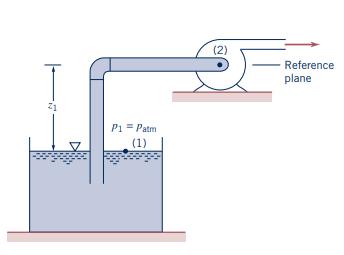In Example 12.3, how will the maximum height, (z_{1}), that the pump can be located above the
Question:
In Example 12.3, how will the maximum height, \(z_{1}\), that the pump can be located above the water surface change if the water temperature is decreased to \(40^{\circ} \mathrm{F}\)?
Example 12.3
A centrifugal pump is to be placed above a large, open water tank, as shown in Fig. 12.13, and is to pump water at a rate of \(0.5 \mathrm{ft}^{3} / \mathrm{s}\). At this flowrate the required net positive suction head, \(\mathrm{NPSH}_{\mathrm{R}}\), is \(15 \mathrm{ft}\), as specified by the pump manufacturer. The water temperature is \(80^{\circ} \mathrm{F}\) and atmospheric pressure is 14.7 psi. Assume that the major head loss between the tank and the pump inlet is due to a filter at the pipe inlet having a minor loss coefficient \(K_{L}=20\). Other losses can be neglected. The pipe on the suction side of the pump has a diameter of \(4 \mathrm{in}\).
Determine the maximum height that the pump can be located above the water surface without cavitation. If you were required to place a valve in the flow path, would you place it upstream or downstream of the pump? Why?
Fig. 12.13

Step by Step Answer:

Munson Young And Okiishi's Fundamentals Of Fluid Mechanics
ISBN: 9781119080701
8th Edition
Authors: Philip M. Gerhart, Andrew L. Gerhart, John I. Hochstein





